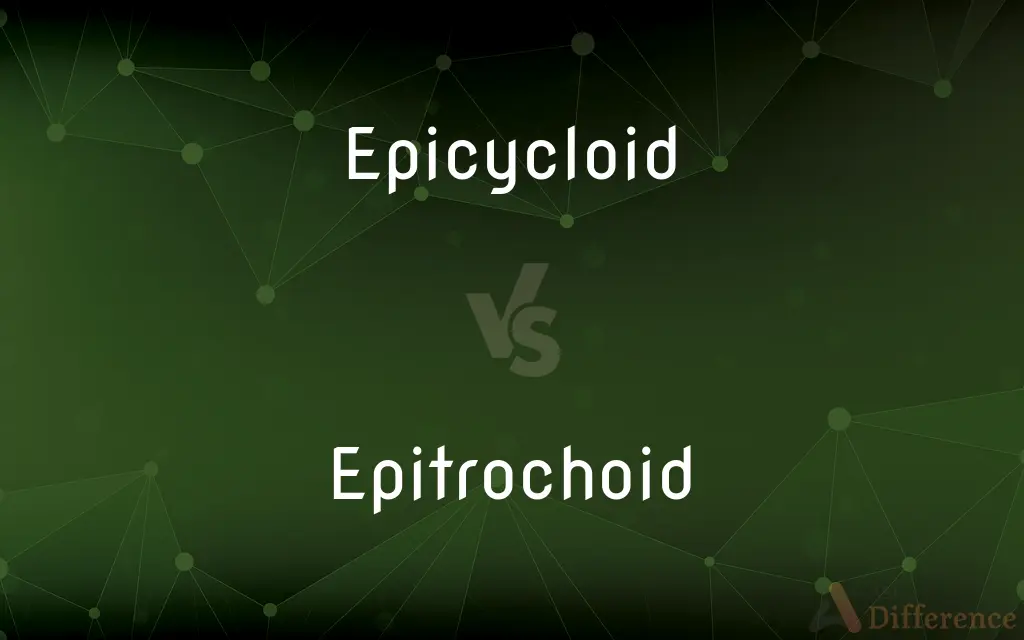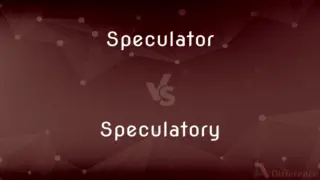Epicycloid vs. Epitrochoid — What's the Difference?
By Tayyaba Rehman & Maham Liaqat — Updated on April 8, 2024
An epicycloid is traced by a point on a circle rolling outside another circle, focusing on radial paths; epitrochoid, by contrast, involves a point within or outside the rolling circle, offering diverse shapes.

Difference Between Epicycloid and Epitrochoid
Table of Contents
ADVERTISEMENT
Key Differences
An epicycloid is generated when a circle rolls around the outside of another circle without slipping, and a point on the circumference of the rolling circle traces a path in space. This creates radially symmetrical shapes. On the other hand, an epitrochoid is produced under similar conditions but with the tracing point located anywhere relative to the rolling circle's circumference, not limited to the outer edge. This flexibility results in a wider variety of shapes, including loops and more complex curves.
Epicycloids are characterized by their distinct, often star-like shapes, with the number of cusps (points) depending directly on the ratio of the radii of the two circles involved. Whereas epitrochoids, due to the tracing point's variable position, can have elongated, looped, or even heart-shaped patterns, which are not limited to the radial symmetry of epicycloids.
In the case of an epicycloid, the tracing point's distance from the center of the rolling circle is equal to the rolling circle's radius. This results in paths that are directly influenced by the diameter of the rolling circle. In contrast, for epitrochoids, the tracing point's distance from the rolling circle's center can be greater than, less than, or equal to the rolling circle's radius, leading to a greater diversity of path shapes.
The mathematical representation of an epicycloid involves equations that account for the radii of both circles and the position of the tracing point on the rolling circle's circumference. Epitrochoids, meanwhile, include an additional variable in their equations: the distance of the tracing point from the rolling circle's center, allowing for the creation of a broader range of curves.
While both epicycloids and epitrochoids are examples of roulette curves, where one curve rolls without slipping along another curve, their applications in engineering and design differ due to their shape properties. Epicycloids often find their use in gear tooth design for their smooth and predictable paths, whereas epitrochoids are utilized in the design of rotary engines and piston shapes, where more complex motion paths are beneficial.
ADVERTISEMENT
Comparison Chart
Definition
Path traced by a point on a circle rolling outside another circle
Path traced by a point related to a circle rolling outside another circle
Tracing Point Position
On the circumference of the rolling circle
Any position relative to the rolling circle
Shape Variety
Limited, often star-like with radial symmetry
More diverse, including loops and complex curves
Mathematical Representation
Depends on the radii of both circles
Includes an additional variable for the tracing point's distance
Applications
Gear tooth design, mechanical animations
Rotary engines, piston designs, more complex mechanical systems
Compare with Definitions
Epicycloid
A curve traced by a point on the circumference of a circle as it rolls around the outside of another circle.
A classic example of an epicycloid is the shape of a five-pointed star when a circle rolls around another circle of the same size.
Epitrochoid
A curve generated by tracing a point that does not have to be on the circumference of a rolling circle.
An epitrochoid can form intricate patterns like heart shapes or elongated loops, depending on the tracing point's position.
Epicycloid
Found in mechanical designs where rolling motion without slipping is involved.
The teeth of certain gears are shaped like epicycloids for efficient motion transfer.
Epitrochoid
Offers more flexibility in shape design than epicycloids due to the variable position of the tracing point.
Designers prefer epitrochoids for creating unique logo designs and art.
Epicycloid
A type of roulette curve resulting from the motion of one circle on another without slipping.
Designers use epicycloids to create smooth, symmetrical patterns for jewelry.
Epitrochoid
Its mathematical model includes variables for both the radii of the circles involved and the distance of the tracing point from the rolling circle's center.
Mathematicians study epitrochoids to understand their properties and potential applications in engineering.
Epicycloid
Characterized by its radial symmetry and the number of cusps.
An epicycloid produced when the rolling circle is half the size of the fixed circle results in a three-cusped shape.
Epitrochoid
Can produce loops and other features not found in epicycloids due to the additional degree of freedom.
Epitrochoids are studied for their potential in creating novel mechanical movements and animations.
Epicycloid
The mathematical representation involves equations using the radii of the fixed and rolling circles.
Engineers calculate the exact shape of an epicycloid for gear design using specific radii ratios.
Epitrochoid
Used in the design of rotary engines where complex motion paths are required.
The epitrochoid shape is critical for the efficiency of Wankel rotary engines.
Epicycloid
In geometry, an epicycloid is a plane curve produced by tracing the path of a chosen point on the circumference of a circle—called an epicycle—which rolls without slipping around a fixed circle. It is a particular kind of roulette.
Epitrochoid
An epitrochoid ( or ) is a roulette traced by a point attached to a circle of radius r rolling around the outside of a fixed circle of radius R, where the point is at a distance d from the center of the exterior circle. The parametric equations for an epitrochoid are x ( θ ) = ( R + r ) cos θ − d cos ( R + r r θ ) , {\displaystyle x(\theta )=(R+r)\cos \theta -d\cos \left({R+r \over r}\theta \right),\,} y ( θ ) = ( R + r ) sin θ − d sin ( R + r r θ ) .
Epicycloid
The curve described by a point on the circumference of a circle as the circle rolls on the outside of the circumference of a second, fixed circle.
Epitrochoid
A geometric curve traced by a fixed point on one circle which rotates around the perimeter of another circle. Examples include the shape of the Wankel engine Category:en:Curves
Epicycloid
(geometry) The locus of a point on the circumference of a circle that rolls without slipping on the circumference of another circle. Category:en:Curves
Epitrochoid
A kind of curve. See Epicycloid, any Trochoid.
Epicycloid
A curve traced by a point in the circumference of a circle which rolls on the convex side of a fixed circle.
Epicycloid
A line generated by a point on a circle rolling around another circle
Common Curiosities
Can both epicycloids and epitrochoids form closed curves?
Yes, both can form closed curves if the ratio of the radii of the two circles is a rational number.
What differentiates an epicycloid from an epitrochoid?
The main difference is the position of the tracing point; on the circle's circumference for epicycloids and anywhere relative to the circle for epitrochoids, leading to different shapes.
Are epicycloids always symmetrical?
Yes, epicycloids are radially symmetrical, depending on the radii ratio of the involved circles.
Can epitrochoids be used in gear design?
While less common than epicycloids, epitrochoids can be used in specialized gear designs where unique contact patterns are beneficial.
How does the tracing point's position affect an epitrochoid's shape?
The position can significantly alter the shape, allowing for loops, cusps, and more complex patterns than epicycloids.
What is the significance of the tracing point in an epicycloid?
The tracing point's position (on the circumference) directly influences the epicycloid's shape, producing distinct, radially symmetrical patterns.
Can the shape of an epitrochoid be predicted easily?
Predicting the exact shape requires understanding the mathematical relationship between the rolling circle's radius, the fixed circle's radius, and the tracing point's distance from the rolling circle's center.
What mathematical fields study epicycloids and epitrochoids?
Geometry, specifically the study of curves and their properties, focuses on both epicycloids and epitrochoids.
Do epitrochoids require more complex equations for their creation?
Yes, epitrochoids involve an additional variable for the tracing point's position, making their mathematical representation more complex than that of epicycloids.
How do the applications of epicycloids and epitrochoids differ in engineering?
Epicycloids are often used in gear design for smooth operation, while epitrochoids find applications in more complex systems like rotary engines.
Is it possible to create an epitrochoid with a tracing point inside the rolling circle?
Yes, placing the tracing point inside the rolling circle can produce unique epitrochoid shapes not possible with epicycloids.
Can epitrochoids and epicycloids be used in animations?
Yes, both curves are used in animations and mechanical simulations for their visually appealing and predictable motion paths.
Are there any natural occurrences of epicycloids or epitrochoids?
While natural occurrences are rare, the principles behind these curves can be observed in certain physical phenomena and biological structures.
Are there any simple tools to create epicycloids and epitrochoids?
Yes, there are digital tools and software that allow for the creation and visualization of these curves by adjusting parameters.
How does the ratio of the radii affect the number of cusps in an epicycloid?
The number of cusps in an epicycloid is determined by the ratio of the radii of the rolling circle to the fixed circle.
Share Your Discovery

Previous Comparison
Speculator vs. Speculatory
Next Comparison
Rock vs. ScapoliteAuthor Spotlight
Written by
Tayyaba RehmanTayyaba Rehman is a distinguished writer, currently serving as a primary contributor to askdifference.com. As a researcher in semantics and etymology, Tayyaba's passion for the complexity of languages and their distinctions has found a perfect home on the platform. Tayyaba delves into the intricacies of language, distinguishing between commonly confused words and phrases, thereby providing clarity for readers worldwide.
Co-written by
Maham Liaqat













































